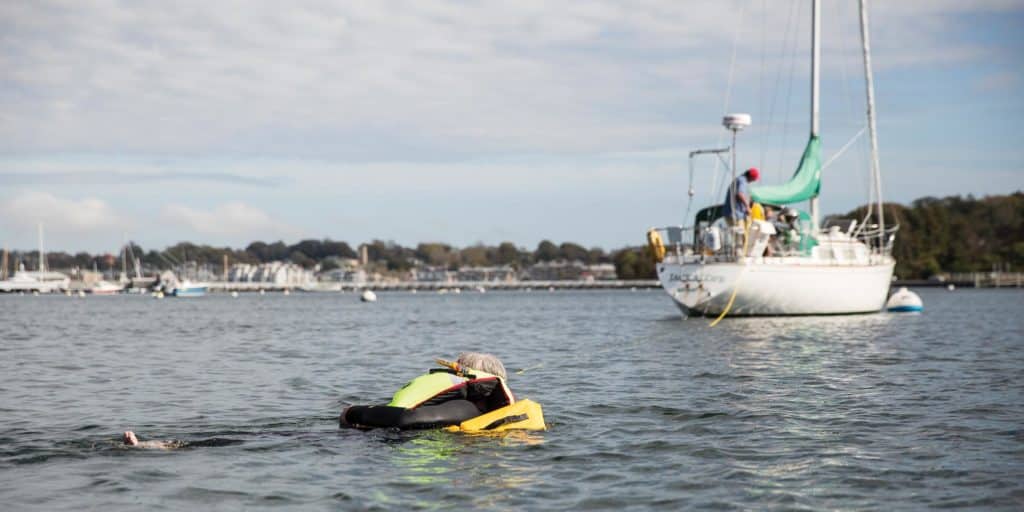
It’s the equipment you hope you never need. A crewmember falling overboard ranks high on most sailors’ list of fears. Crew-overboard gear is an important part of any well-outfitted sailboat, and items such as the ubiquitous Lifesling or a horseshoe buoy can be spotted on the transoms of most vessels. These items, and a slew of others on the market, can all aid in getting a COB back on board — but what’s the right gear for your boat? Recently, we tried out some rescue items, and we have a few take-aways from the experience.
The first is this: Don’t fall overboard. Even when you’re just practicing on a calm day with plenty of experienced sailors aboard, getting a person back on the boat is challenging. When offshore, wear a harness and tether secured to through-bolted fittings and the strong lines or webbing between them, practice good seamanship and keep one hand for the boat. Ensure that your deck has plenty of handholds going forward, and sturdy, well-maintained lifelines that are ideally 30 inches high.
Our other take-aways were: Practice with your gear, and there is no magic bullet. Hauling up a COB is a workout on a good day. On a day when the wind, seas and tensions are high, it’s bound to be more difficult. Time is of the essence in rescues, and this is not the occasion to be figuring out new gear. A good mindset to have is that seamanship and quick thinking are what are going to save that person in the water; consider the gear as a tool.
With these things in mind, let’s take a look at what’s available and how these items can work together. According to the Annapolis Book of Seamanship, a COB rescue can be broken down into three steps: locate, make contact and recover. Some of the gear items assist in one segment of the rescue; other items, all three. However you choose to outfit your boat, be sure to consider all three parts of the rescue and how you will accomplish each.
Locate
It’s been said that searching for a head in the water is similar to looking for a half-submerged coconut. Now, if this happens at night or in any kind of seas, you’ll need all the help you can get. Classic COB poles and lights are effective in helping those on board spot the person in the water, and all crew PFDs should be outfitted with a small strobe light, such as the ACR C-Strobe or Firefly, and a whistle.
Electronics that can alert the rest of the crew to an overboard situation are a worthwhile addition to your kit and can direct the person on the helm to the victim. We checked out personal beacons that use the automatic identification system (AIS) to locate a victim, as well as app-based products. ACR’s AIS Link ($270) and Ocean Signal’s RescueMe MOB1 ($280) are two popular AIS-based COB devices. Both are tiny and can easily be integrated into an inflatable life jacket. When activated, they send an alert message to all nearby AIS-equipped vessels and activate the digital selective calling alarm on the VHF. A benefit of an AIS-based device over a traditional satellite-based personal locator beacon is that it could potentially allow for a faster rescue by alerting all AIS-equipped boats in the vicinity instead of using satellites to notify search-and-rescue organizations. It should be noted that different makes and vintages of chart plotters and AIS-equipped VHF radios might display the target and alert messages differently, and the units must be programmed with the vessel’s Maritime Mobile Service Identity number in order to use the DSC individual distress call function.
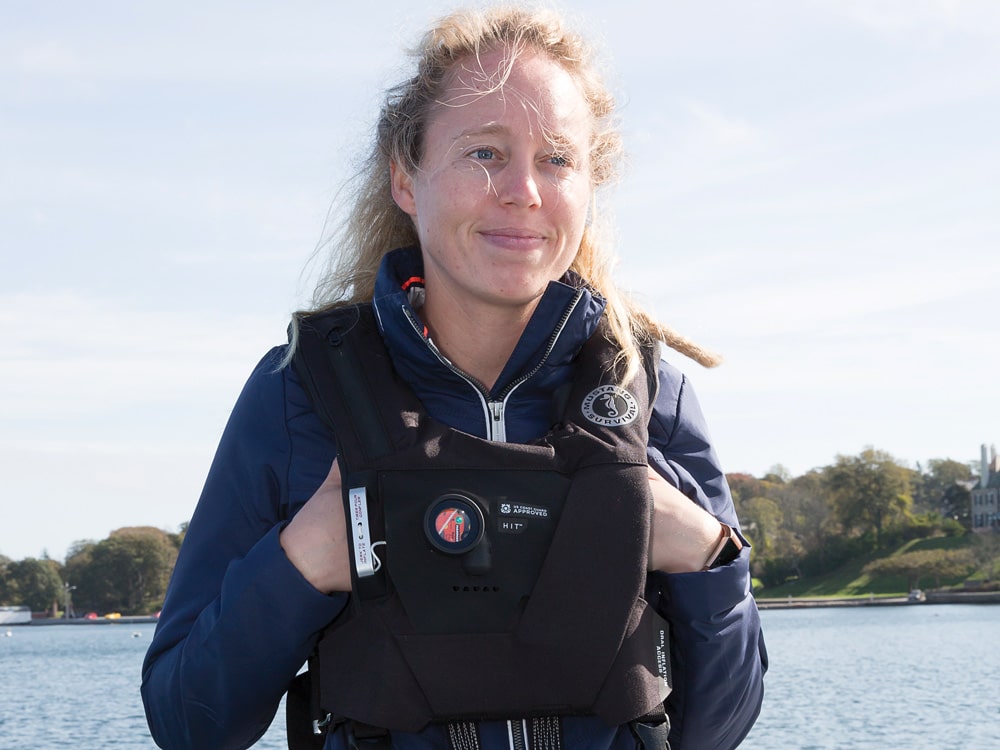
The app-based products we tried included the CrewWatcher ($90), Sea Tags ($85) and OLAS ($60). These simple devices all essentially work the same way: Each crewmember wears a tag that is paired to a mobile device running the app. If the tag is either submerged in water or is too far away from the monitoring phone or tablet, an alarm sounds and the location of where the tag’s signal was lost is displayed. A directional heading is then displayed on the app to guide the helmsperson back to the COB. These products use Bluetooth (not cellular) connectivity to work, as well as the location services on a mobile device. That said, it can definitely be taxing on your phone or tablet’s battery. These products are simple enough to use, and affordable enough for each crewmember to have their own tag (including pets!), which could offer doublehanded crews some peace of mind. Be sure to completely familiarize yourself with the app before leaving the dock.
Make Contact and Recover
The “make contact” portion of a rescue operation involves connecting the boat and the victim as quickly as possible. Providing additional flotation quickly will both improve their visibility in the water and help them stay afloat until contact and rescue. We tried out two simple throwable devices, Mustang Survival’s Rescue Stick and the Survivor ThrowRaft, and three contact-and-retrieval items, Switlik’s MOM 8-S, Ocean Signal’s Jonbuoy and the Lifesling.
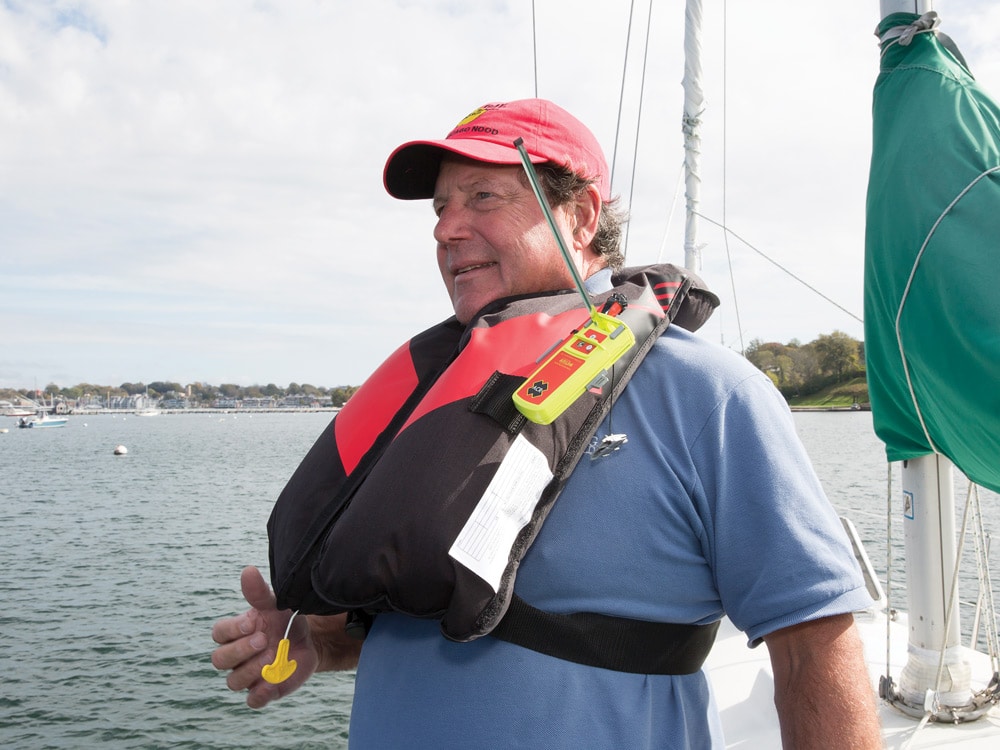
Both the Mustang Survival Rescue Stick ($160) and the ThrowRaft ($130) are easy to use. You simply toss them in the water close to the overboard victim and they automatically inflate. In practice, I found the Rescue Stick a bit easier to throw a long distance, and its inflatable horseshoe flotation device was easy for our “victim” to climb into. The ThrowRaft inflates to something about the size and shape of a typical Type IV cushion. Both these items are small and can be stored easily in a cockpit locker. The Rescue Stick and the ThrowRaft are user-serviceable, and the rearm kits each run between $25 and $30. Both the Rescue Stick and ThrowRaft could be used in tandem with other COB gear.
The Switlik MOM is available in either a hard case (the MOM 8-A, $600) or a soft valise (the MOM 8-S, $450). Both models are designed to be stored on the stern railing and are instantly deployed with the tug of a handle. The MOM (which stands for man-overboard module) consists of an inflatable 6-foot pylon with a light at the top, horseshoe-shaped flotation device and a sea anchor to keep the victim from drifting too far. The MOM 8-S unit we tried seems well-made and was simple to launch. Although we practiced in a flat calm, the lighted pylon would definitely improve visibility during an actual rescue in rougher conditions. Once the COB is near the boat, a halyard can be attached to the lifting straps for recovery. It should be noted that the MOM 8-A needs to be sent in every two years for recertification, which runs about $120. The MOM 8-S can be serviced annually by the user for about $30.
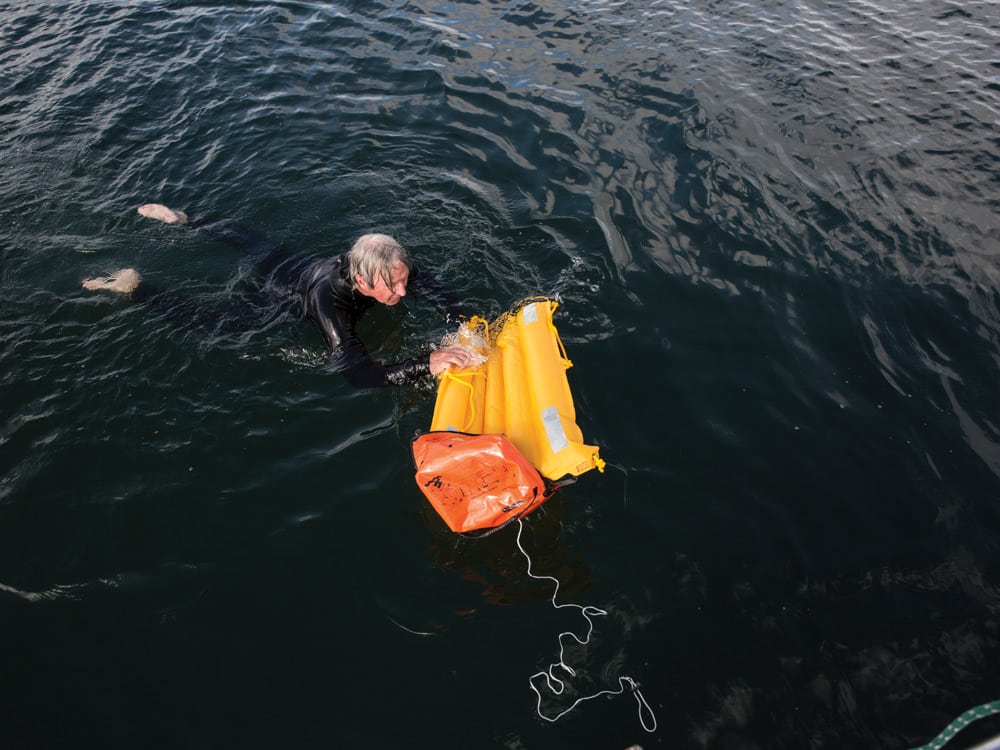
Similar to the MOM unit, Revere Safety’s Jonbuoy recovery module ($1,100) mounts on a stern railing and is released by pulling a lever. The Jonbuoy recovery module consists of an inflatable raft platform with an attached lighted pylon for visibility. Water ballast pockets keep it stable. Our favorite feature of the recovery module is that it allows the COB to actually get out of the water, which should improve their chances against developing hypothermia while waiting for rescue. To recover, attach a halyard to the lifting loop located near the top of the pylon, which is much easier to reach from the deck than a loop at water level, and hoist the entire module to the deck.
The Lifesling is a tried-and-true choice for overboard recovery aboard many sailboats. Unlike the MOM or Jonbuoy, the Lifesling ($150) stays attached to the boat with a long polypropylene line. The instructions are simple — just toss the floating sling and all line in the water and circle around the victim, which brings the trailing life ring close to him or her. Once the victim is in the sling, the crew can pull him or her close to the boat (the person in the water should ride facing backward while being towed to the boat to avoid a face full of water). To retrieve, attach a halyard (or, a block and tackle rigged to the halyard) to the Lifesling and hoist.
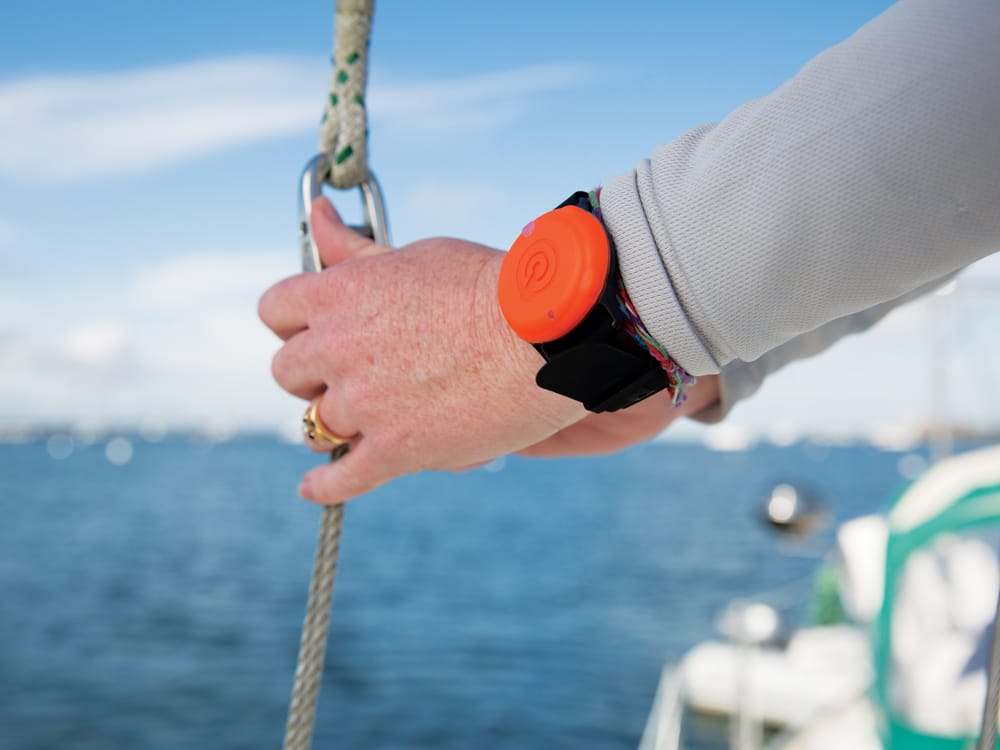
A definite plus for the Lifesling is that there is nothing inflatable (the ring is foam), and there are no moving parts. Without the need to rearm it or send it in to have it serviced, crews can practice with it as much as they want. It’s a good idea to inspect it regularly, rinse it in fresh water and repack the line to ensure it’s not fouled. Lifesling also has available a specially made 3-to-1 lifting tackle for purchase.
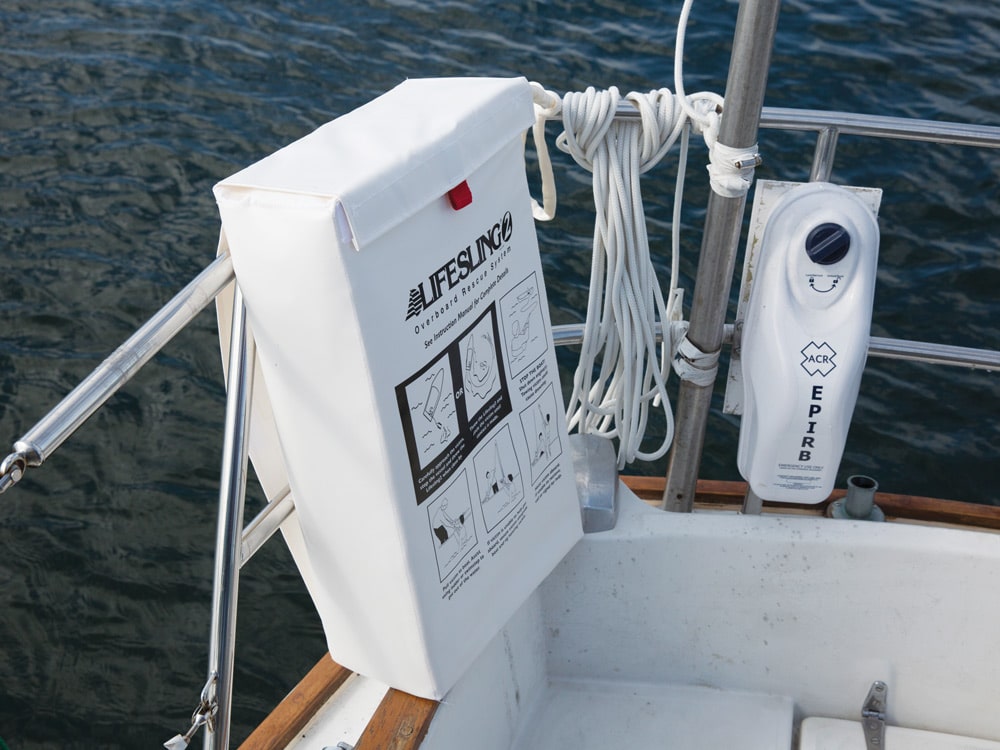
Conclusions
When it came time to hoist our victim for the day back aboard, there was nothing easy about it. This is one stage of the recovery that deserves plenty of thought and practice, particularly if the crew is shorthanded or of dissimilar sizes. With any of these retrieval methods, if there is a swim ladder aboard, particularly one that goes over the side, be sure to rig it to give the COB some footing when coming back aboard. Also, if you plan on using a block and tackle to assist in the recovery, have it ready and know where all the hardware is kept. Having other items available could be handy in the moment, such as a throw line (like Mustang Survival’s Throw Bag ($80), with 75 feet of line), extra flotation and a spotlight.
Above all though, remember a successful rescue comes down to the good seamanship skills that are born from making a plan, practicing with the crew and knowing how to use the gear when seconds count.
Jennifer Brett is CW’s senior editor.
Catch and Lift
The Catch and Lift is a new crew-overboard retrieval product that caught our eye at the recent Newport International Boat Show. This system consists of three parts, each clearly labeled: the pulley, which is attached to the boat with a strong snap hook; the rescue sling, which is steered to the victim in a similar way as the Lifesling; and a small sea anchor, which is tossed in the water. The sea anchor is what makes this system interesting — it’s located at the other end of the line attached to the COB, and once it’s deployed, the boat’s speed (ideally around 1 knot) drags the sea anchor through the water, which hoists the COB in toward the boat. Having this happen automatically allows the person aboard to stay at the helm until it’s time to get the victim aboard. It’s an innovative concept, and one we’d like to try out for a future issue. Check out videos of the Catch and Lift in action at the U.S. distributor’s website.








